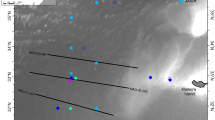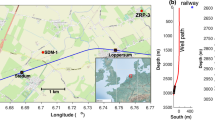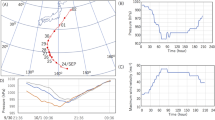Abstract
IN the years immediately preceding the War, considerable progress was made in the use at sea of the seismic method of studying submarine geology, and work wascarried as far as the 100-fathom line. Further progresstodeeper water was rendered difficult by the troubles arising in putting the instruments and explosives on thebottom of the sea. As a result of work in 1938 and 1939, itwas suggested1 that it might be possible to avoid these difficulties by having the instruments hanging in the water and relying on the transmission of the seismic waves from the bottom into the water. Unpublished observationsduring the War, both in Great Britain and in the United States, showed that seismic waves could, in fact, be observed in this way. In order to test the possibilities ofthe method, a direct comparison has been made of the signal received by a geophone on the bottom and by a hydrophone in the water. The explosive was also hanging in the water.
This is a preview of subscription content, access via your institution
Access options
Subscribe to this journal
Receive 51 print issues and online access
$199.00 per year
only $3.90 per issue
Buy this article
- Purchase on Springer Link
- Instant access to full article PDF
Prices may be subject to local taxes which are calculated during checkout
Similar content being viewed by others
References
Bullard, E. C., and Gaskell, T. F., Proc. Roy. Soc, A, 177, 498 (1941).
Author information
Authors and Affiliations
Rights and permissions
About this article
Cite this article
HILL, M., WlLLMORE, P. Marine Seismic Prospecting. Nature 159, 707–708 (1947). https://doi.org/10.1038/159707a0
Issue Date:
DOI: https://doi.org/10.1038/159707a0
Comments
By submitting a comment you agree to abide by our Terms and Community Guidelines. If you find something abusive or that does not comply with our terms or guidelines please flag it as inappropriate.



